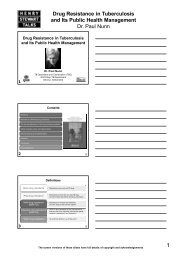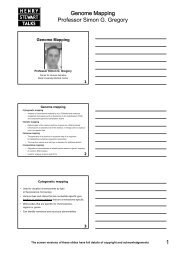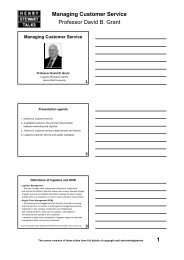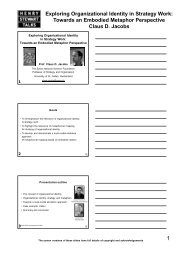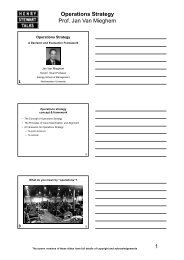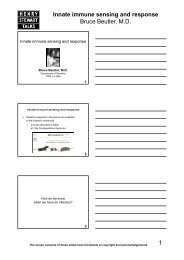Quantitative Financial Risk Management - Henry Stewart Talks
Quantitative Financial Risk Management - Henry Stewart Talks
Quantitative Financial Risk Management - Henry Stewart Talks
You also want an ePaper? Increase the reach of your titles
YUMPU automatically turns print PDFs into web optimized ePapers that Google loves.
III: Market <strong>Risk</strong><br />
Estimating <strong>Risk</strong> Models<br />
Professor Kevin Dowd, Centre for <strong>Risk</strong> and Insurance Studies<br />
Nottingham University Business School<br />
Defining a risk model – Assembling data – Non-parametric<br />
estimation methods – Parametric estimation methods – Monte<br />
Carlo simulation methods<br />
Measures of <strong>Financial</strong> <strong>Risk</strong><br />
Professor Kevin Dowd, Centre for <strong>Risk</strong> and Insurance Studies<br />
Nottingham University Business School<br />
Nature of financial risk – Representing financial risk using a<br />
density function – VaR as a risk measure – Expected shortfall –<br />
Coherent risk measures – Worst-case scenario analyses<br />
Nonlinear VaR Models<br />
Dr Simon Hubbert, School of Economics, Mathematics and<br />
Statistics, Birkbeck, University of London<br />
When faced with estimating the value at risk for a non-linear<br />
portfolio a practitioner will often resort to simulation<br />
methods. For large portfolios the computational time required<br />
for this can be enormous. This presentation provides a selfcontained<br />
introduction and overview of analytical techniques<br />
which can be used to provide Value at <strong>Risk</strong> estimates for such<br />
portfolios. Accurate closed form estimates are appealing as<br />
they circumvent the computational demands.<br />
IV: Applications to Credit <strong>Risk</strong> and Market <strong>Risk</strong><br />
Structural and Reduced Form Models<br />
Dr Theo Darsinos – Fixed Income Research, Deutsche Bank<br />
AG<br />
Structural Models – The Merton Approach – Bond pricing,<br />
Stock pricing, Default probability, Credit spreads, Bond<br />
volatility – Parameter estimation – Limitations – Extending<br />
Merton: The creditgrades model<br />
Reduced Form Models – Default intensity – Examples:<br />
Constant, Deterministic and Stochastic intensities – Linking<br />
reduced and structural models – Recovery rates<br />
Modelling Business Dependencies for Credit<br />
Portfolios<br />
Dr Markus A. Leippold, the Swiss Banking Institute, University<br />
of Zürich<br />
Portfolio credit risk – Integrating macrostructural and<br />
microstructural interdependencies – Gaussian copula – Credit<br />
portfolio as a graph – Impact of business dependencies on<br />
correlation – Feedback effects – Marginal risk contribution<br />
Extreme Value Theory<br />
Professor Paul Embrechts, Professor of Mathematics and Dr<br />
Johanna Neslehova, Postdoctoral Research Fellow, <strong>Risk</strong><br />
<strong>Management</strong> Research Centre <strong>Risk</strong>Lab, ETH Zürich at the<br />
ETHZ (Swiss Federal Institute of Technology, Zürich)<br />
Extremes in quantitative risk management – Limiting<br />
behaviour of sums and maxima – Fisher/Tippett theorem –<br />
Extreme value distributions and domains of attraction – Block<br />
maxima method – Threshold exceedances –<br />
Pickands/Balkema/de Haan theorem – Threshold selection –<br />
Quantile estimation – Point process approach – Banking and<br />
insurance regulation – Critical appraisal<br />
Copulas<br />
Professor Paul Embrechts, Professor of Mathematics and Dr<br />
Johanna Neslehova, Postdoctoral Research Fellow, <strong>Risk</strong><br />
<strong>Management</strong> Research Centre <strong>Risk</strong>Lab, ETH Zürich at the<br />
ETHZ (Swiss Federal Institute of Technology, Zürich)<br />
Impact of extremes and dependence in finance and insurance<br />
– Correlation issues – Copulas and Sklar’s theorem – Copula<br />
generation – Fréchet-Hoeffding bounds – Limitations of<br />
correlation – Rank correlation measures – An application to<br />
credit risk – Tail dependence – Bounds on risk measures –<br />
Critical appraisal<br />
V: <strong>Risk</strong> Model Validation<br />
Validation Techniques I: Regulatory and Statistical<br />
Background<br />
Dr Dirk Tasche, Banking and <strong>Financial</strong> Supervision<br />
Department, Deutsche Bundesbank<br />
Historical background – New capital standards (Basel II) –<br />
Requirements on quantitative validation – The binary<br />
classification model for rating systems – Bayes’ formula –<br />
Modelling cyclical effects – Conditional probabilities of default<br />
(PD)<br />
Validation Techniques II: Discriminatory Power and<br />
Calibration<br />
Dr Dirk Tasche, Banking and <strong>Financial</strong> Supervision<br />
Department, Deutsche Bundesbank<br />
Validation principles – Predictive ability, discriminatory power,<br />
and PD calibration – Cumulative accuracy profile (CAP) –<br />
Accuracy ratio (AR) – Receiver operating characteristic –<br />
Kolmogorov-Smirnov statistic – Conditional and unconditional<br />
tests – Binomial test – Hosmer-Lemeshow test – Spiegelhalter<br />
test – Normal test<br />
VI: Economic Capital<br />
Leading Bank Credit Portfolio Strategies<br />
Mr Brian Dvorak, Moody’s KMV Credit Strategies Group<br />
• Leading banks manage their credit portfolios actively<br />
• Active credit portfolio management objectives<br />
and principles<br />
• Active credit portfolio management trends and<br />
success stories<br />
• Leading bank economic capital management strategies<br />
• Uses of required economic capital at leading banks<br />
• Leading bank credit portfolio management organisational<br />
models<br />
• Leading bank credit portfolio management strategies<br />
• Adopting leading bank strategies





